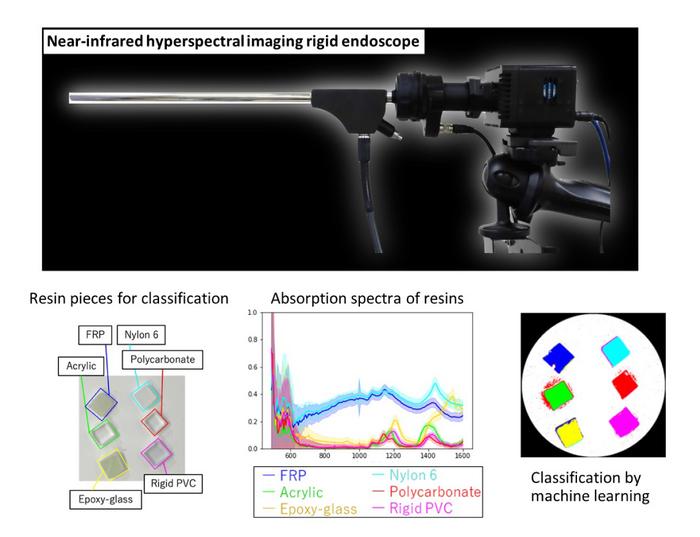Hyperspectral imaging (HSI) is a state-of-the-art technique that captures and processes information across a given electromagnetic spectrum. Unlike traditional imaging techniques that capture light intensity at specific wavelengths, HSI collects a full spectrum at each pixel in an image. This rich spectral data enables the distinction between different materials and substances based on their unique spectral signatures. Near-infrared hyperspectral imaging (NIR-HSI) has attracted significant attention in the food and industrial fields as a non-destructive technique for analyzing the composition of objects. A notable aspect of NIR-HSI is over-thousand-nanometer (OTN) spectroscopy, which can be used for the identification of organic substances, their concentration estimation, and 2D map creation. Additionally, NIR-HSI can be used to acquire information deep into the body, making it useful for the visualization of lesions hidden in normal tissues.

Credit: Hiroshi Takemura from Tokyo University of Science
Hyperspectral imaging (HSI) is a state-of-the-art technique that captures and processes information across a given electromagnetic spectrum. Unlike traditional imaging techniques that capture light intensity at specific wavelengths, HSI collects a full spectrum at each pixel in an image. This rich spectral data enables the distinction between different materials and substances based on their unique spectral signatures. Near-infrared hyperspectral imaging (NIR-HSI) has attracted significant attention in the food and industrial fields as a non-destructive technique for analyzing the composition of objects. A notable aspect of NIR-HSI is over-thousand-nanometer (OTN) spectroscopy, which can be used for the identification of organic substances, their concentration estimation, and 2D map creation. Additionally, NIR-HSI can be used to acquire information deep into the body, making it useful for the visualization of lesions hidden in normal tissues.
Various types of HSI devices have been developed to suit different imaging targets and situations, such as for imaging under a microscope or portable imaging and imaging in confined spaces. However, for OTN wavelengths, ordinary visible cameras lose sensitivity and only a few commercially available lenses exist that can correct chromatic aberration. Moreover, it is necessary to construct cameras, optical systems, and illumination systems for portable NRI-HSI devices, but no device that can acquire NIR-HSI with a rigid scope, crucial for portability, has been reported yet.
Now, in a new study, a team of researchers, led by Professor Hiroshi Takemura from Tokyo University of Science (TUS) and including Toshihiro Takamatsu, Ryodai Fukushima, Kounosuke Sato, Masakazu Umezawa, and Kohei Soga, all from TUS, Hideo Yokota from RIKEN, and Abian Hernandez Guedes and Gustavo M. Calico, both from the University of Las Palmas de Gran Canaria, has recently developed the world’s first rigid endoscope system capable of HSI from visible to OTN wavelengths. Their findings were published in Volume 32, Issue 9 of Optics Express on April 17, 2024.
At the core of this innovative system lies a supercontinuum (SC) light source and an acoustic-opto tunable filter (AOTF) that can emit specific wavelengths. Prof. Takemura explains, “An SC light source can output intense coherent white light, whereas an AOTF can extract light containing a specific wavelength. This combination offers easy light transmission to the light guide and the ability to electrically switch between a broad range of wavelengths within a millisecond.”
The team verified the optical performance and classification ability of the system, demonstrating its capability to perform HSI in the range of 490–1600 nm, enabling visible as well as NIR-HSI. Additionally, the results highlighted several advantages, such as the low light power of extracted wavelengths, enabling non-destructive imaging, and downsizing capability. Moreover, a more continuous NIR spectrum can be obtained compared to that of conventional rigid-scope-type devices.
To demonstrate their system’s capability, the researchers used it to acquire the spectra of six types of resins and employed a neural network to classify the spectra pixel-by-pixel in multiple wavelengths. The results revealed that when the OTN wavelength range was extracted from the HSI data for training, the neural network could classify seven different targets, including the six resins and a white reference, with an accuracy of 99.6%, reproducibility of 93.7%, and specificity of 99.1%. This means that the system can successfully extract molecular vibration information of each resin at each pixel.
Prof. Takemura and his team also identified several future research directions for improving this method, including enhancing image quality and recall in the visible region and refining the design of the rigid endoscope to correct chromatic aberrations over a wide area. With these further advancements, in the coming years, the proposed HSI technology is expected to facilitate new applications in industrial inspection and quality control, working as a “superhuman vision” tool that unlocks new ways of perceiving and understanding the world around us.
“This breakthrough, which combines expertise from different fields through a collaborative, cross-disciplinary approach, enables the identification of invaded cancer areas and the visualization of deep tissues such as blood vessels, nerves, and ureters during medical procedures, leading to improved surgical navigation. Additionally, it enables measurement using light previously unseen in industrial applications, potentially creating new areas of non-use and non-destructive testing,” remarks Prof. Takemura. “By visualizing the invisible, we aim to accelerate the development of medicine and improve the quality of life of physicians as well as patients.”
***
Reference
Title of original paper: Development of a visible to 1600 nm hyperspectral imaging rigid-scope system using supercontinuum light and an acousto-optic tunable filter
Journal: Optics Express
DOI: https://doi.org/10.1364/OE.515747
About The Tokyo University of Science
Tokyo University of Science (TUS) is a well-known and respected university, and the largest science-specialized private research university in Japan, with four campuses in central Tokyo and its suburbs and in Hokkaido. Established in 1881, the university has continually contributed to Japan’s development in science through inculcating the love for science in researchers, technicians, and educators.
With a mission of “Creating science and technology for the harmonious development of nature, human beings, and society,” TUS has undertaken a wide range of research from basic to applied science. TUS has embraced a multidisciplinary approach to research and undertaken intensive study in some of today’s most vital fields. TUS is a meritocracy where the best in science is recognized and nurtured. It is the only private university in Japan that has produced a Nobel Prize winner and the only private university in Asia to produce Nobel Prize winners within the natural sciences field.
Website: https://www.tus.ac.jp/en/mediarelations/
About Professor Hiroshi Takemura from Tokyo University of Science
Hiroshi Takemura is currently a Professor at the Department of Mechanical and Aerospace Engineering, Faculty of Science and Technology, Tokyo University of Science (TUS). He received his B.S. degree in engineering from Kyushu Institute of Technology, Fukuoka, Japan in 1999. He then went to the Nara Institute of Science and Technology where he received his M.S. (2001) and Ph.D. (2003) degrees in information engineering. At TUS, he currently leads the Biomechanics Research Lab. He has over 200 publications to his name and has received over 500 citations. His research interests include robotics, gait analysis, human modeling, informatics, and perceptual information processing.
Funding information
This study was supported by the Japanese Society for the Promotion of Science KAKENHI (Grant No. 21H038440), the National Cancer Center Research and Development Fund (Grant No. 31-A-11, 2023-A-9), AMED (Grant No. 23he0422027j0001, 23ym0126806j0002;Seed Number: A417TS) and “Agencia Canaria de Investigacion, Innovacion y Sociedad de la Información (ACIISI)” of the “Consejería de Economía, Conocimiento y Empleo”, which is part-financed by the European Social Fund (FSE) (POC 2014-2020, Eje 3 Tema Prioritario 74 (85\%)).
Journal
Optics Express
DOI
10.1364/OE.515747
Method of Research
Imaging analysis
Subject of Research
Not applicable
Article Title
Development of a visible to 1600 nm hyperspectral imaging rigid-scope system using supercontinuum light and an acousto-optic tunable filter
Article Publication Date
17-Apr-2024
COI Statement
The authors have no relevant financial interests or any other potential conflicts of interest to disclose.




